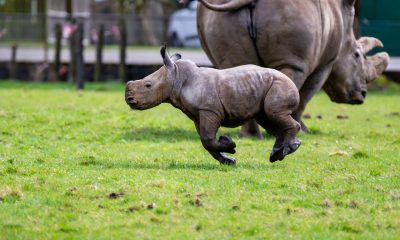Intensive farming turned wild plant into invasive weed
"Farming and climate change are driving rapid plant evolution.”
Published
1 year ago onBy
Talker News
By Stephen Beech via SWNS
Intensive farming turned a wild plant into an invasive weed, warns a new study.
Researchers found that agriculture is driving rapid evolutionary change, not just on farms but also in wild species in surrounding landscapes.
The study shows how the rise of modern farming methods has turned a North American native plant, common waterhemp, into a problematic agricultural weed.
An international research team compared 187 waterhemp samples from modern farms and neighboring wetlands with more than 100 historical samples dating as far back as 1820 that had been stored in museums across North America.

(Julia Kreiner via SWNS
Much like the sequencing of ancient human and neanderthal remains has resolved key mysteries about human history, studying the plant’s genetic makeup over the last two centuries allowed the researchers to watch evolution in action across changing environments.
Study first author Dr. Julia Kreiner said: “The genetic variants that help the plant do well in modern agricultural settings have risen to high frequencies remarkably quickly since agricultural intensification in the 1960s,”
The team discovered hundreds of genes across the weed’s genome that aid its success on farms, with mutations in genes related to drought tolerance, rapid growth and resistance to herbicides appearing frequently.
Dr. Kreiner, of the University of British Columbia (UBC), Canada, said: “The types of changes we’re imposing in agricultural environments are so strong that they have consequences in neighboring habitats that we’d usually think were natural."
She says the findings, published in the journal Science, could inform conservation efforts to preserve natural areas in landscapes dominated by agriculture.
Dr. Kreiner explained that reducing gene flow out of agricultural sites and choosing more isolated natural populations for protection could help limit the evolutionary influence of farms.
Common waterhemp is native to North America and was not always a problematic plant.
However, in recent years the weed has become nearly impossible to eradicate from farms thanks to genetic adaptations including herbicide resistance.
Co-author Professor Sarah Otto, also of UBC, said: “While waterhemp typically grows near lakes and streams, the genetic shifts that we’re seeing allow the plant to survive on drier land and to grow quickly to outcompete crops.
“Waterhemp has basically evolved to become more of a weed given how strongly it’s been selected to thrive alongside human agricultural activities.”
The researchers say that five out of seven herbicide-resistant mutations found in current samples were absent from the historical samples.
Dr. Kreiner said: “Modern farms impose a strong filter determining which plant species and mutations can persist through time.

“Sequencing the plant’s genes, herbicides stood out as one of the strongest agricultural filter determining which plants survive and which die.”
She said waterhemp conducting any of the seven herbicide-resistant mutations has produced an average of 1.2 times as many surviving offspring per year since 1960 compared to plants that don’t have the mutations.
Herbicide-resistant mutations were also discovered in natural habitats, albeit at a lower frequency, which the researchers say raises questions about the costs of the adaptations for plant life in non-agricultural settings.
Dr. Kreiner said: “In the absence of herbicide applications, being resistant can actually be costly to a plant, so the changes happening on the farms are impacting the fitness of the plant in the wild."
She said that agricultural practices have also reshaped where particular genetic variants are found across the landscape.
Dr. Kreiner explained that, over the last 60 years, a weedy southwestern variety has made an increasing progression eastward across North America, spreading their genes into local populations as a result of their competitive edge in agricultural contexts.
Co-author Professor Stephen Wright, of the University of Toronto, Canada, said: “These results highlight the enormous potential of studying historical genomes to understand plant adaptation on short timescales.
“Expanding this research across scales and species will broaden our understanding of how farming and climate change are driving rapid plant evolution.”
Co-author Professor John Stinchcombe, also of the University of Toronto, added: “Understanding the fate of these variants and how they affect plants in non-farm, ‘wild’ populations is an important next step for our work."
Stories and infographics by ‘Talker Research’ are available to download & ready to use. Stories and videos by ‘Talker News’ are managed by SWNS. To license content for editorial or commercial use and to see the full scope of SWNS content, please email [email protected] or submit an inquiry via our contact form.
You may like


Giant prehistoric salmon used tusk-like teeth to fight off predators


Evidence of Earth’s magnetic field dates back 3.7 billion years


New research reveals early galaxies evolved much faster than thought


Majority of American moms and dads feel lonely and burned out


Hospital patients treated by women doctors are less likely to die


Majority of parents ‘customize’ meals for picky kids
Other Stories


Pro mermaid’s career goes swimmingly after overcoming ocean fear
She makes up to $8,000 a show.


Giant prehistoric salmon used tusk-like teeth to fight off predators
The species that grew up to nine feet long lived in the North American Pacific Northwest.


Evidence of Earth’s magnetic field dates back 3.7 billion years
Life on Earth would not be possible without its magnetic field.


Adorable video shows baby rhino enjoying sunshine
By Faye Mayern via SWNS An endangered baby rhino has well and truly found its feet after being filmed playing...


Hilarious moment delivery man gets chased by tiny dog
The hilarious encounter was caught on video.
Top Talkers

 Parenting7 days ago
Parenting7 days agoSingle mom details struggles of feeding her 12 kids

 Lifestyle6 days ago
Lifestyle6 days agoWoman regrets her tattoo nightmare: ‘It’s horrendous’

 Good News2 days ago
Good News2 days agoDisabled student takes first steps in 10 years on graduation stage

 Broadcast1 week ago
Broadcast1 week agoOver 40% of Americans have no clue what a 401k is

 Health3 days ago
Health3 days agoNew study reveals ‘old age’ begins later than it used to

 Broadcast1 week ago
Broadcast1 week agoHow hard is it for Americans to live sustainably?

 Money1 week ago
Money1 week agoOver 40% of Americans have no clue what a 401k is

 Wildlife2 days ago
Wildlife2 days agoClever elephant returns visitor’s shoe after falling into enclosure
